PETALING JAYA: The implementation of the radio frequency identification (RFID) system to collect toll has raised ire among some motorists.
Most complain that it does not work properly, leaving the special lanes for RFID users more congested than other lanes.
But, according to an expert in robotics technology, it is the future. It will mean no more toll booths, leading to zero congestion. On the other hand stakeholders agree that the kinks will have to be ironed out first.
Malaysia Automotive, Robotics and IoT Institute (MARii) chief executive officer Datuk Madani Sahari is upbeat about the possibilities offered by the technology.
“The RFID is just part of the evolution of transport technology, moving us towards intelligent transport systems,” he told theSun.
He said that while the current discussions have centred on its implementation at the toll collection booths, he believes the technology will improve over time and the challenges will be overcome. “We will be able to scale up operational capabilities in the near future.”
PLUS Malaysia, which operates the North-South Highway, recently implemented the RFID system at its toll booth as a move towards easing out the use of the Touch ’n Go system.
However, technical failures and other problems led to long queues at the toll booths, leaving many motorists irked.
Madani said the RFID technology should be seen as a stepping stone towards more advanced technology revolving around intelligent transport systems (ITS) in Malaysia.
He explained that the objective of constructing highways has always been to move large volumes of traffic across long distances with as little congestion as possible.
“However, putting toll booths in the path of moving traffic is a major source of congestion, which is counter-productive,” he said.
Madani said it is important to ensure toll collection be made as efficient as possible to minimise inconvenience to the very same road users who are paying to use the highway.
He said the adoption of updated technology, including the RFID, was the first milestone in the journey towards multi-lane free flow (MLFF) traffic. This entails high speed toll collection on the highways, he added.
“MLFF is one of the many elements that make up ITS. In ITS, information and communications technologies are used to improve transportation as well as mitigate or solve problems,” Madani said.
He said ITS applications and solutions also encompass increased safety, security and reliability during travel.
“It helps travellers to better managed their travel time, routes and choice of transport. It also helps to reduce congestion, pollution and loss of productivity,” he added.
Madani explained that ITS applications require the latest advancements and emerging applications in artificial intelligence, internet-of-things, the Fourth Industrial Revolution, smart city developments, connect and automated vehicles as well as connected and cooperative systems.
“MARii is working on various technologies that are part and parcel of ITS. These include systems integration and cloud infrastructure for e-payment solutions, big data management and intelligent grid technology,” Madani said.
He said the important takeaway from the implementation of the RFID system is that the country is addressing the need for the appropriate technology, system and direction towards achieving ITS.
“The recent discussions on the relevant technologies such as automated number plate recognition, payment gateway liberalisation and other technological issues are an important step towards ensuring that the awareness and utilisation of such technologies can be optimised. This will then ensure a better future for intelligent transport in Malaysia,” he added.










